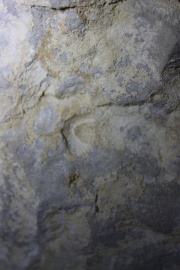Fossils (Inventory)/Brachiopod
From LagWiki
(Difference between revisions)
(Added a reference) |
|||
| (2 intermediate revisions not shown) | |||
| Line 1: | Line 1: | ||
| + | {{Inventory image|File:Brachiopod.jpg|Brachiopod}} | ||
The '''Brachiopod''' field of the [[Fossils (Inventory)|Fossils]] section should be used to record any observation of fossil brachiopods. | The '''Brachiopod''' field of the [[Fossils (Inventory)|Fossils]] section should be used to record any observation of fossil brachiopods. | ||
Brachiopods are marine animals with a hinged, two-part shell on the top and bottom as opposed to the left and right arrangement of [[Fossils (Inventory)/Clam|clams]]. They are, therefore, a bivalve but are not really related to other bivalve mollusks. Brachiopods also have a coiled, rigid cartilaginous internal structure called a lophophore, which sometimes appears in fossils. | Brachiopods are marine animals with a hinged, two-part shell on the top and bottom as opposed to the left and right arrangement of [[Fossils (Inventory)/Clam|clams]]. They are, therefore, a bivalve but are not really related to other bivalve mollusks. Brachiopods also have a coiled, rigid cartilaginous internal structure called a lophophore, which sometimes appears in fossils. | ||
| - | Brachiopods and clams are sometimes difficult to distinguish as fossils. | + | Brachiopods and clams are sometimes difficult to distinguish as fossils. If the impression is bilaterally symmetrical, it is probably a brachiopod. If asymmetrical, it is probably a clam. |
| + | |||
| + | Brachiopod impressions can occur in large clusters. | ||
==See also== | ==See also== | ||
| Line 10: | Line 13: | ||
==References== | ==References== | ||
*Romero, Aldemaro (2009) ''Cave Biology; Life in Darkness'' Cambridge University Press, New York p 89 ISBN-Hardback: [[Special:Booksources/978-0-521-82846-8|978-0-521-82846-8]], ISBN-Paperback: [[Special:Booksources/978-0-521-53553-3|978-0-521-53553-3]] | *Romero, Aldemaro (2009) ''Cave Biology; Life in Darkness'' Cambridge University Press, New York p 89 ISBN-Hardback: [[Special:Booksources/978-0-521-82846-8|978-0-521-82846-8]], ISBN-Paperback: [[Special:Booksources/978-0-521-53553-3|978-0-521-53553-3]] | ||
| + | *Coleman, Mary Carol and Cameron Coleman (2010) ''Fossils of Guadalupe Mountains National Park'' Carlsbad Caverns Guadalupe Mountains Association pp 23-26, http://www.ccgma.org | ||
{{Cave inventory}} | {{Cave inventory}} | ||
| - | |||
Current revision as of 18:37, 7 March 2018
The Brachiopod field of the Fossils section should be used to record any observation of fossil brachiopods.
Brachiopods are marine animals with a hinged, two-part shell on the top and bottom as opposed to the left and right arrangement of clams. They are, therefore, a bivalve but are not really related to other bivalve mollusks. Brachiopods also have a coiled, rigid cartilaginous internal structure called a lophophore, which sometimes appears in fossils.
Brachiopods and clams are sometimes difficult to distinguish as fossils. If the impression is bilaterally symmetrical, it is probably a brachiopod. If asymmetrical, it is probably a clam.
Brachiopod impressions can occur in large clusters.
See also
References
- Romero, Aldemaro (2009) Cave Biology; Life in Darkness Cambridge University Press, New York p 89 ISBN-Hardback: 978-0-521-82846-8, ISBN-Paperback: 978-0-521-53553-3
- Coleman, Mary Carol and Cameron Coleman (2010) Fossils of Guadalupe Mountains National Park Carlsbad Caverns Guadalupe Mountains Association pp 23-26, http://www.ccgma.org

